هل كنت تعاني من نقص في الموظفين وتجاوزت ميزانيتك وقلقك بشأن الوفاء بالمواعيد النهائية في منتصف الطريق في مشروع ما؟ 👀
إذا كان الأمر كذلك، فسيسعدك أن تعرف أن هناك طريقة لتقليل فرص حدوث ذلك مرة أخرى. أدخل تخطيط القدرات.
يُعرف أيضًا باسم تخطيط الطلب أو التنبؤ بالطلب، يعد تخطيط السعة عنصرًا حاسمًا في إدارة المشروع. عند القيام به بشكل صحيح، يمكن أن يوفر الكثير من الوقت والطاقة والنفقات خلال مشروعك.
في هذا الدليل، سنقوم بتعريف الأنواع المختلفة لاستراتيجيات تخطيط السعة ونقدم لك عملية تساعدك على البدء، مع أمثلة ونماذج لتسهيل الطريق. طبّق هذه المبادئ على مشروعك التالي، وسترى مدى سهولة تطبيقها!
ما هو تخطيط السعة؟
الهدف من تخطيط السعة هو تقدير متطلباتك من الموارد لإكمال مشروع معين في إطار زمني معين.
يراعي تخطيط السعة الفعال ما يلي:
- مقدار العمل الذي يجب إنجازه والمدة الزمنية التي من المحتمل أن يستغرقها
- مجموعات المعرفة والمهارات المطلوبة لإنجاز هذا العمل
- أعضاء الفريق المتاحين للعمل في المشروع
- الوقت الذي يمكن أن يخصصه الفريق لذلك
- أي مواد أو معدات أو برمجيات مطلوبة
- حدود ميزانية المشروع
تخطيط القدرات هو في الأساس معادلة العرض مقابل الطلب. بمعنى آخر، هل سيكون لديك الموارد التي تحتاجها عندما تحتاج إليها؟ ⚖️
إذا لم يكن الأمر كذلك، فستحتاج إلى التخطيط لكيفية الحصول عليها في الوقت المناسب. على سبيل المثال، ربما تحتاج إلى زيادة عدد الموظفين لديك أو استعارة الموارد من قسم آخر للمساعدة على أساس مؤقت. من ناحية أخرى، إذا كانت لديك قدرة فائضة، يمكنك إعادة توجيهها إلى مبادرات أخرى.
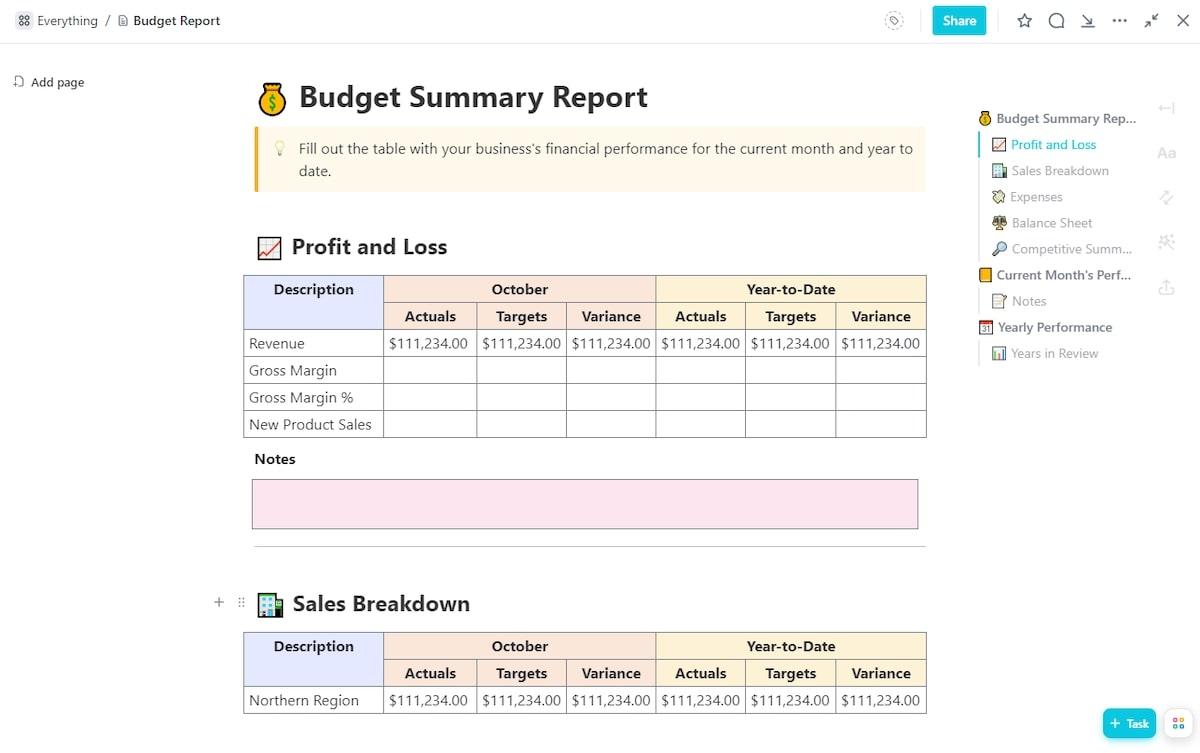
إنشاء تقارير احترافية وشاملة للميزانية بسهولة في ClickUp
تخطيط سعة الموارد هو مجرد الخطوة الأولى من إدارة الموارد . بمجرد الانتهاء من التخطيط، ستحتاج إلى تخصيص تلك الموارد إلى الجزء المحدد من المشروع الذي يناسبهم بشكل أفضل.
بعد ذلك، ستقوم بمراقبة المشروع من خلال استخدام الموارد للتحقق مما إذا كانت تقديراتك دقيقة. إذا كانت هذه الموارد مستغلة بشكل زائد أو ناقص، أو إذا تغيرت احتياجاتك من السعة، يمكنك إجراء أي تعديلات ضرورية بسرعة لتحسين تخصيص الموارد.
فوائد تخطيط السعة
عندما تقوم بتخطيط السعة بشكل جيد، يستفيد المشروع بأكمله بطرق متعددة:
- تحسين إدارة سلسلة التوريد: يضمن لك التخطيط الجيد للموارد أنك لن تضطر إلى التعامل مع نقص المواد الخام أو المعدات. سيكون لديك ما تحتاجه لمواصلة الإنتاج وفقًا لخطة مشروعك
- فرق عمل أكثر إنتاجية: إن التخطيط الجيد لقدرات القوى العاملة المدروسة جيدًا يجعلإدارة عبء العمل سهلاً. أنت تعرف قدرات فريقك ومهاراته، لذا يمكنك التأكد من أن الجميع يعمل بالمستوى الأمثل، مما يؤدي إلى مستويات عالية من رضا الفريق وتقليل الإرهاق
- قليل من أوجه القصور في العمليات: واضحتبعيات المشروع والتخطيط الجيد للموارد يساعدك على تخصيص موارد كافية للأماكن الصحيحة. وهذا يمنع الاختناقات التي تضيع الوقت وتقلل من قدرتك الإنتاجية
- تقليل نفاد المخزون: مع التخطيط الجيد لسعة المنتج، ستتمكن دائمًا من إعطاء العملاء ما يريدونه عندما يريدونه، مما يضمن إنفاقهم أموالهم معك وليس مع منافسيك
- تحسين عملية اتخاذ القرار: عندما يكون لديكخطة واضحة لإدارة المتطلبات بالإضافة إلى إدارة جيدة للسعة، ستكون قادرًا على اتخاذ قرارات مستنيرة في كل خطوة على الطريق، حتى عندما تتغير الأمور أو عندما تريد توسيع نطاق العمل
- عمليات قابلة لإعادة الاستخدام: بمجرد أن تختبر استراتيجية تخطيط السعة وتعرف أنها تعمل، يمكنك إعادة استخدام تلك الخطة كقالب للمشاريع المستقبلية، حتى لا تضطر إلى البدء من الصفر في كل مرة
- ربحية أعلى: مع تحسين جميع عملياتك ومعدلات الاستخدام الجيدة لمواردك، تنخفض التكاليف، مما يحسن من أرباحك النهائية
- إسعاد أصحاب المصلحة: عندما تسير الأمور بسلاسة وترتفع الأرباح، من المرجح أن يشعر أصحاب المصلحة بالرضا

استخدم ClickUp لتعيين ترتيب واضح للعمليات عن طريق إضافة تبعيات "حظر" أو "انتظار" بين المهام
كما فهمتَ على الأرجح، فإن التخطيط الناجح للقدرة ليس مسألة تخمين. فهو يتطلب بيانات حقيقية و تخطيط السيناريوهات -بالإضافة إلى ربما القليل من الغريزة الغريزية. لحسن الحظ، تتوفر استراتيجيات تخطيط القدرات المجربة والمختبرة للمساعدة، مدعومة بمجموعة واسعة من أدوات تخطيط السعة .
استراتيجيات تخطيط السعة ## استراتيجيات تخطيط السعة
هناك عدة طرق مختلفة للتعامل مع تخطيط السعة. كل طريقة لها إيجابيات وسلبيات، وهي مناسبة لأنواع مختلفة من الأعمال التجارية وملامح المخاطر. لنرى ما الذي يمكن أن تقدمه هذه الطرق.
استراتيجية التأخير
يعد تخطيط السعة المتأخرة أكثر الاستراتيجيات تحفظًا. وتهدف إلى تلبية الطلب الفعلي خلال فترة معينة - وليس أكثر من ذلك.
تكمن فائدة هذه الاستراتيجية في الوقت الفعلي في أنك لا تهدر الموارد لأنك تدفع فقط مقابل ما تحتاجه. ومع ذلك، إذا تغير طلب العميل - لنفترض أنك تدير مطعمًا، وكان هناك تدفق مفاجئ للزبائن - فمن المحتمل أن يكون هناك تأخير قبل أن تتمكن من زيادة سعتك لتلبية هذا الطلب.
لا يُعرف العملاء عموماً بصبرهم، لذلك قد يتوجهون إلى منافسيك بدلاً من انتظار أن تلبي الطلب. لذلك، قد تخسر المال على المدى القصير وربما على المدى الطويل إذا أعجبهم ما يقدمه منافسوك.
غالبًا ما تستخدم هذه الاستراتيجية من قبل الشركات التي تبيع منتجات أو خدمات عالية القيمة أو تلك التي تعرف أن ولاء عملائها مضمون.

اعرض أعباء العمل في فريقك في ClickUp لتعيين عمل جديد وتخصيص الموارد
استراتيجية القيادة
يعد تخطيط السعة الرائدة أكثر استشرافًا للمستقبل. هنا، تقوم بتخطيط متطلبات السعة الخاصة بك بناءً على الطلب المستقبلي المتوقع لفترة معينة. يساعدك هذا على الاستفادة من أي طفرات قادمة في المبيعات، على سبيل المثال، خلال عطلات أو أوقات معينة من العام. 📊
ومع ذلك، هناك أيضًا المزيد من المخاطر المرتبطة به. إذا اتضح أن طلبك المتوقع خلال تلك الفترة كان مفرطًا في التفاؤل، فقد ينتهي بك الأمر بمخزون زائد لا يمكنك بيعه أو موظفين جالسين لا يفعلون شيئًا سوى تكلفتك المال.
وتستخدم العديد من شركات البيع بالتجزئة هذه الاستراتيجية للتخطيط لفترات الطلب المرتفع الراسخة والموسمية، مثل العطلات.
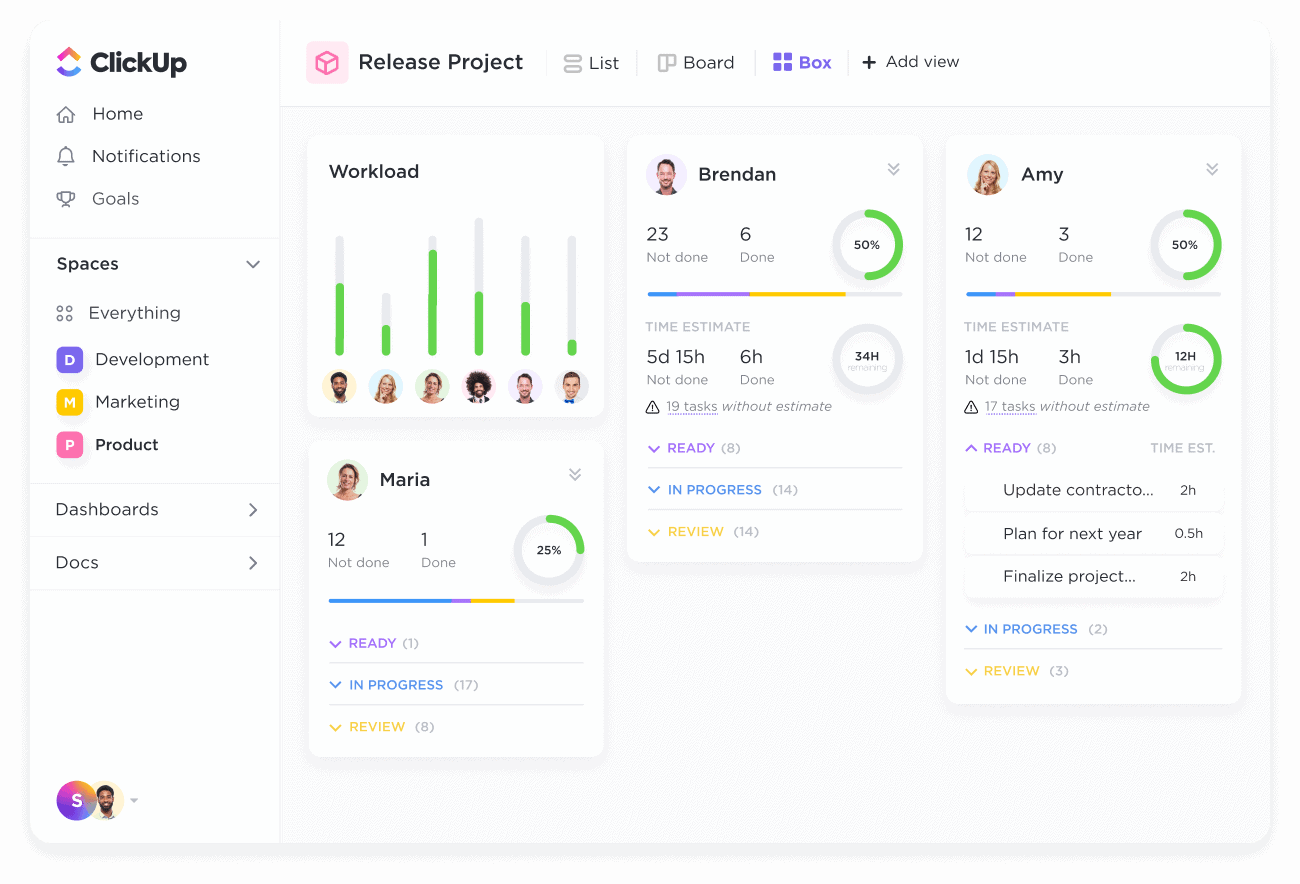
اطلع على ما يعمل عليه فريقك وما أنجزوه وقدراتهم
استراتيجية المطابقة
يقع تخطيط القدرة المطابقة بين هذين النقيضين. ويهدف إلى إيجاد حل وسط من خلال مراقبة تقلبات السوق عن كثب والتخطيط المنتظم للقدرات. كما يتضمن أيضًا التخطيط للطوارئ حول مواردك المتاحة حتى تعرف بالضبط ما ستفعله إذا تغيرت الأمور.
على سبيل المثال، إذا زاد الطلب، قد تزيد سعتك بشكل طفيف في البداية، ولكنك قد تزيد من سعتك قليلاً في البداية ولكن لديك موارد أخرى تحت الطلب في حالة الحاجة إليها. يتيح لك ذلك الاستفادة من الفرص المتاحة دون الالتزام بالموارد مسبقاً.
هذه الاستراتيجية ليست محفوفة بالمخاطر مثل نهج التأخير ولا تزال تسمح بقابلية التوسع. ولهذا السبب، فهي استراتيجية جيدة للعديد من الشركات. ✅
عرض تقديرات الوقت وتتبعها بسهولة في مهام ClickUp لإدارة الموارد بشكل أفضل
كيفية تنفيذ عملية تخطيط السعة
يتطلب التخطيط الفعال للقدرة الاستيعابية العمل من خلال بعض الخطوات للتأكد من أنك قد غطيت جميع القواعد الخاصة بك.
من الممكن القيام بما يلي تخطيط السعة في Excel -وهو بالتأكيد أفضل بكثير من محاولة القيام بذلك يدويًا باستخدام الورق والآلة الحاسبة. ومع ذلك، فإن جدول بيانات Excel ليس أفضل برنامج متاح لتخطيط السعة.
هناك الكثير من موارد تخطيط السعة الجيدة على الإنترنت، وأحد أفضلها هو ClickUp.
ClickUp هو برنامج متكامل لإدارة المشاريع و أداة إنتاجية مجهزة لمساعدتك في تخطيط قدراتك. دعنا نرى كيف يمكنك استخدامها لتنفيذ خطوات العملية.
الخطوة 1: فهم متطلبات مشروعك
تذكر أن هدفك هنا هو التأكد من أن لديك جميع الموارد التي تحتاجها لإكمال المشروع بنجاح. لذلك، من المهم أن تبدأ بفحص ما يجب القيام به بالضبط.
من الناحية المثالية، سيكون لديك وثيقة نطاق المشروع أو ميثاق المشروع. إذا لم يكن الأمر كذلك، قم بتوثيق جميع خطوات المشروع بأفضل ما يمكنك، إلى جانب الأطر الزمنية والأولويات والتبعيات. يمكنك استخدام ClickUp Doc , a ClickUp Whiteboard أو مخطط جانت . 📝
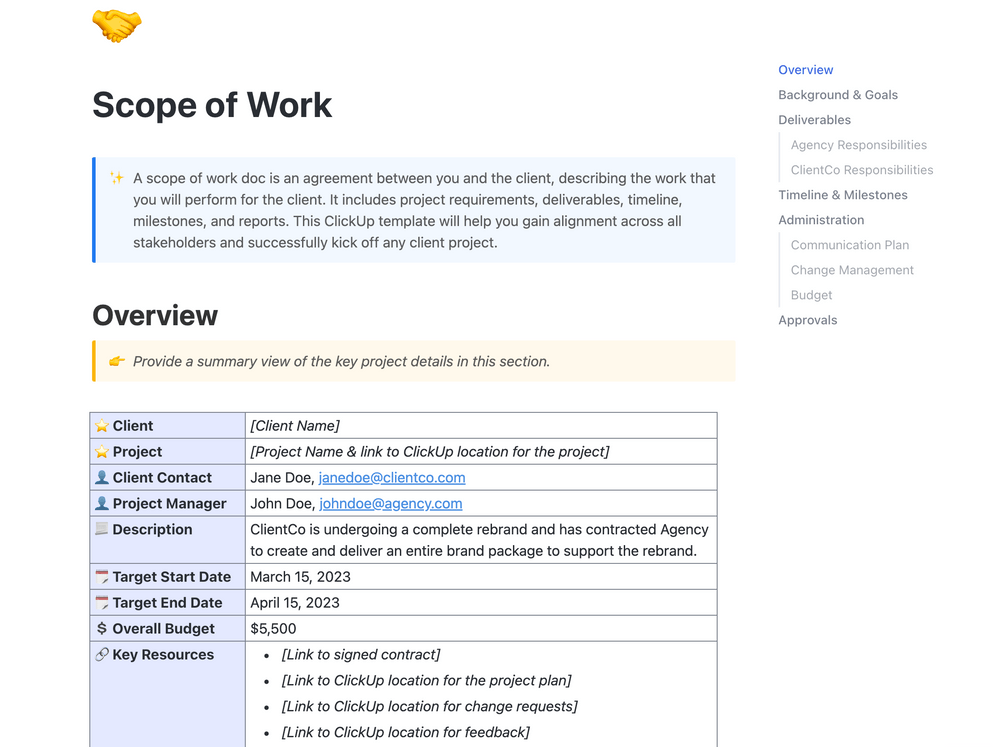
حدد جميع تفاصيل المشروع والموارد المتاحة في مستند ClickUp
الخطوة 2: تقدير السعة التي تحتاجها
استخدم خطة مشروعك لتقدير مقدار الوقت اللازم لإكمال كل خطوة من خطوات المشروع. وللقيام بذلك، استخدم معرفتك وخبرتك بالإضافة إلى أي بيانات تاريخية متوفرة لديك - ولا تخف من استشارة الآخرين الذين قد يكونون قادرين على المساعدة أيضًا. ثم أضف الساعات المقدرة للحصول على المجموع.
إذا كانت هناك مهارات معينة مطلوبة لخطوات مختلفة، فقم بتسليط الضوء عليها لأنها ستحتاج إلى تخصيصها لأشخاص محددين. حدد الأشخاص الذين ترغب في أن يكونوا ضمن فريقك، خاصةً أولئك الذين يتمتعون بمهارات الخبراء الذين تحتاجهم. اذكر أيضاً أي مواد أو معدات قد تحتاجها. 💻
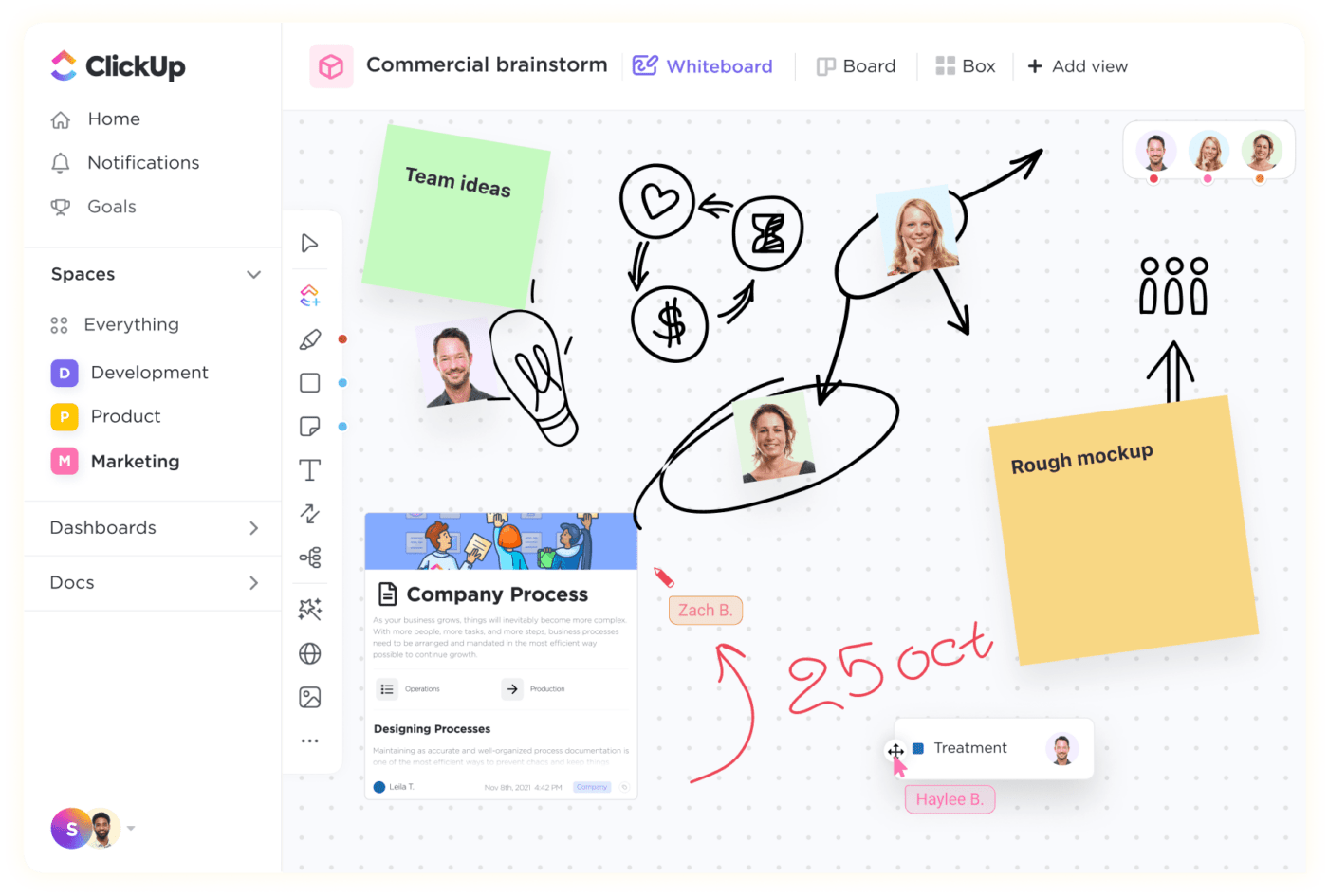
العصف الذهني والتعاون على سبورة ClickUp البيضاء
الخطوة 3: تحقق من قدرة فريقك الحالية انقر فوق عرض عبء العمل مصمم لمساعدتك على ضمان عمل جميع أعضاء فريقك على النحو الأمثل.
تستخدم خاصية عرض عبء العمل المهام التي تخصصها والأطر الزمنية المقدرة لتظهر لك بالضبط مقدار العمل الذي يقوم به كل عضو من أعضاء الفريق - أو لا يقوم به. 🏖️
يتم عرض عبء عمل عضو الفريق على شكل رسم بياني شريطي بالنسبة لقدرته - أي مقدار الوقت المتاح له للعمل - على مدار أسبوع أو أسبوعين أو شهر (أنت تختار الإطار الزمني). يمكنك بسهولة معرفة مقدار الوقت المتبقي لديهم بالضبط للقيام بعمل إضافي. وإذا أردت التعمق في التفاصيل، يمكنك ببساطة النقر لرؤية المهام المحددة التي ينشغلون بها.
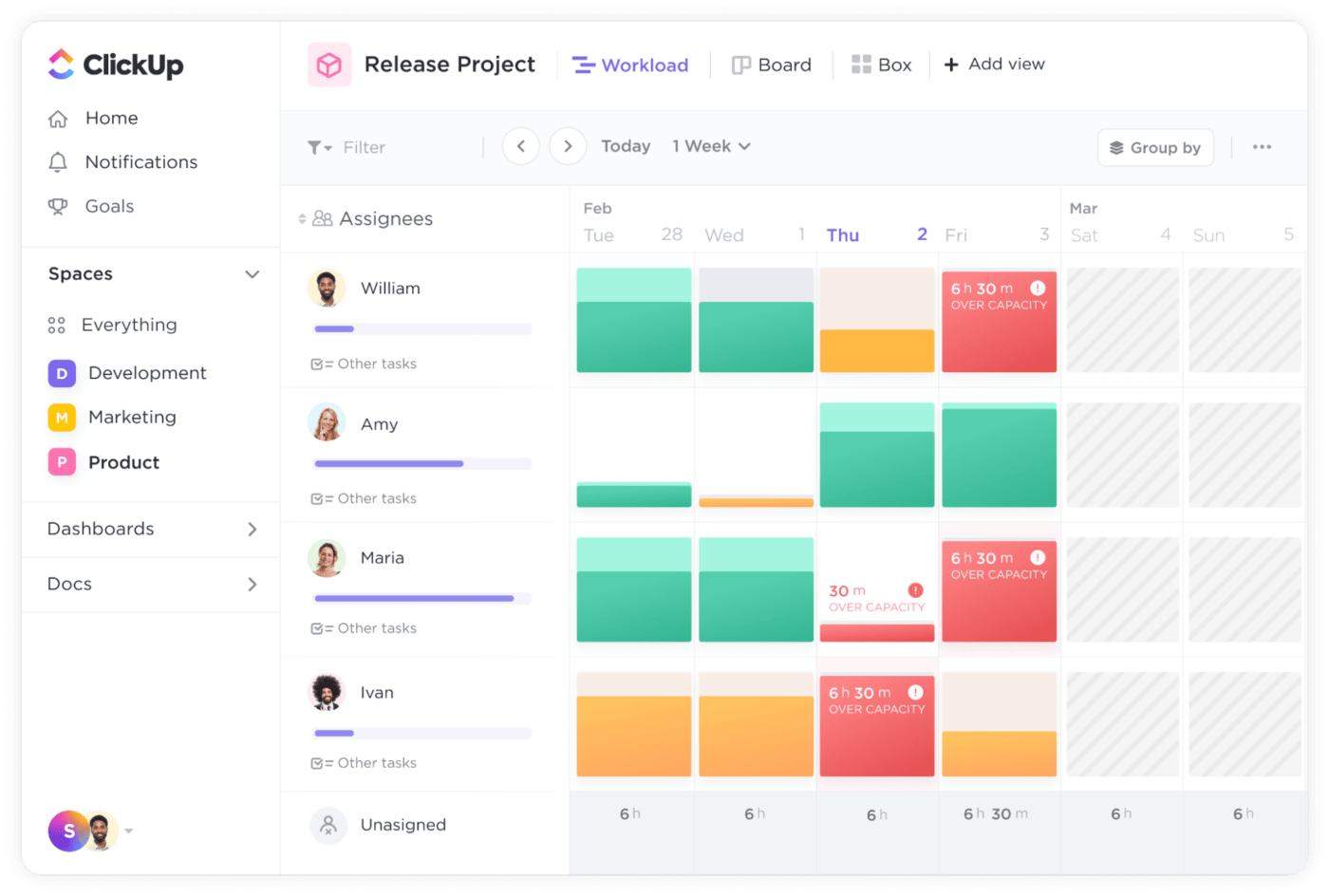
عرض مقدار السعة التي يمتلكها كل عضو في الفريق عبر مساحة العمل الخاصة بك
الخطوة 4: ضع في اعتبارك الفجوة
الآن بعد أن عرفت مقدار السعة المتاحة لفريقك للعمل على مشروعك الجديد، يمكنك حساب أي فجوات في السعة. على سبيل المثال، لنفترض أن المشروع يتطلب 200 ساعة من نوع معين من العمل في الأسبوع، لكن فريقك لديه 100 ساعة فقط من السعة المتاحة. عندئذٍ، ستحتاج إلى توظيف متعاقدين مؤقتين أو متعاقدين مستقلين للساعات المائة الإضافية. 🙋♀️
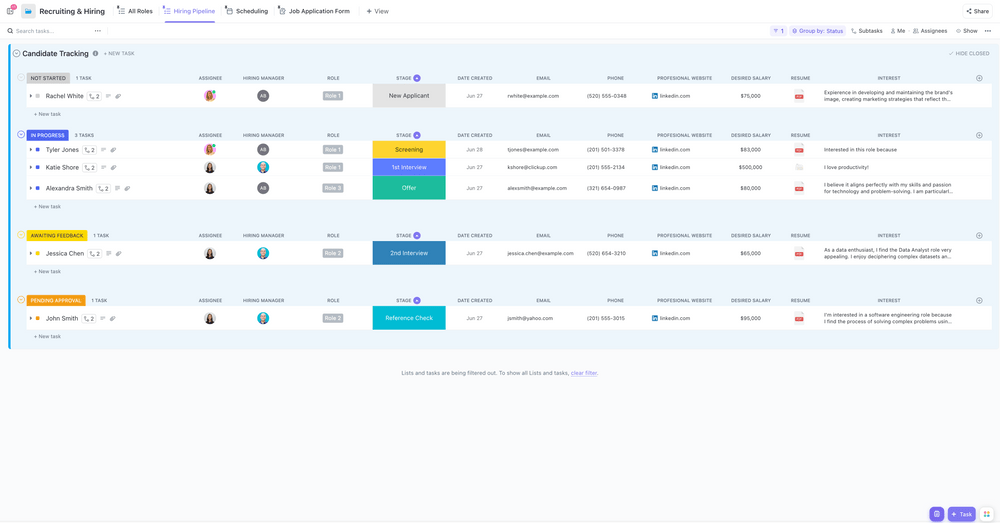
استخدم أدوات تخطيط القدرات في ClickUp أثناء عملية التوظيف لسهولة التتبع
الخطوة 5: مراقبة القدرة الاستيعابية باستمرار
التقدير أمر ضروري للبدء في تخطيط السعة، لكن الأمور تتغير والحياة الواقعية لا تسير دائمًا وفقًا للخطة. قد تستغرق بعض المهام وقتًا أطول مما كنت تعتقد، وقد يكون هناك بعض زحف النطاق أو قد يصاب أعضاء الفريق بالمرض.
راقب عن كثب كيف تتقدم الأمور حتى تتمكن من ضبط تخطيط قدراتك أثناء تقدمك. استخدم لوحة تحكم ClickUp القابلة للتخصيص للاطلاع على التحليلات في الوقت الفعلي وإنشاء التقارير بسرعة عندما تحتاج إليها، حتى تعرف دائمًا ما يحدث ويمكنك الاستجابة بسرعة لأي إشارات حمراء. 🚩
إذا كنت ترغب في التعمّق في تعلّم كيفية تحسين تخطيط قدراتك، اشترك مجانًا في دورة جامعة ClickUp حول كيفية تعظيم تخطيط السعة باستخدام طريقة عرض عبء العمل.
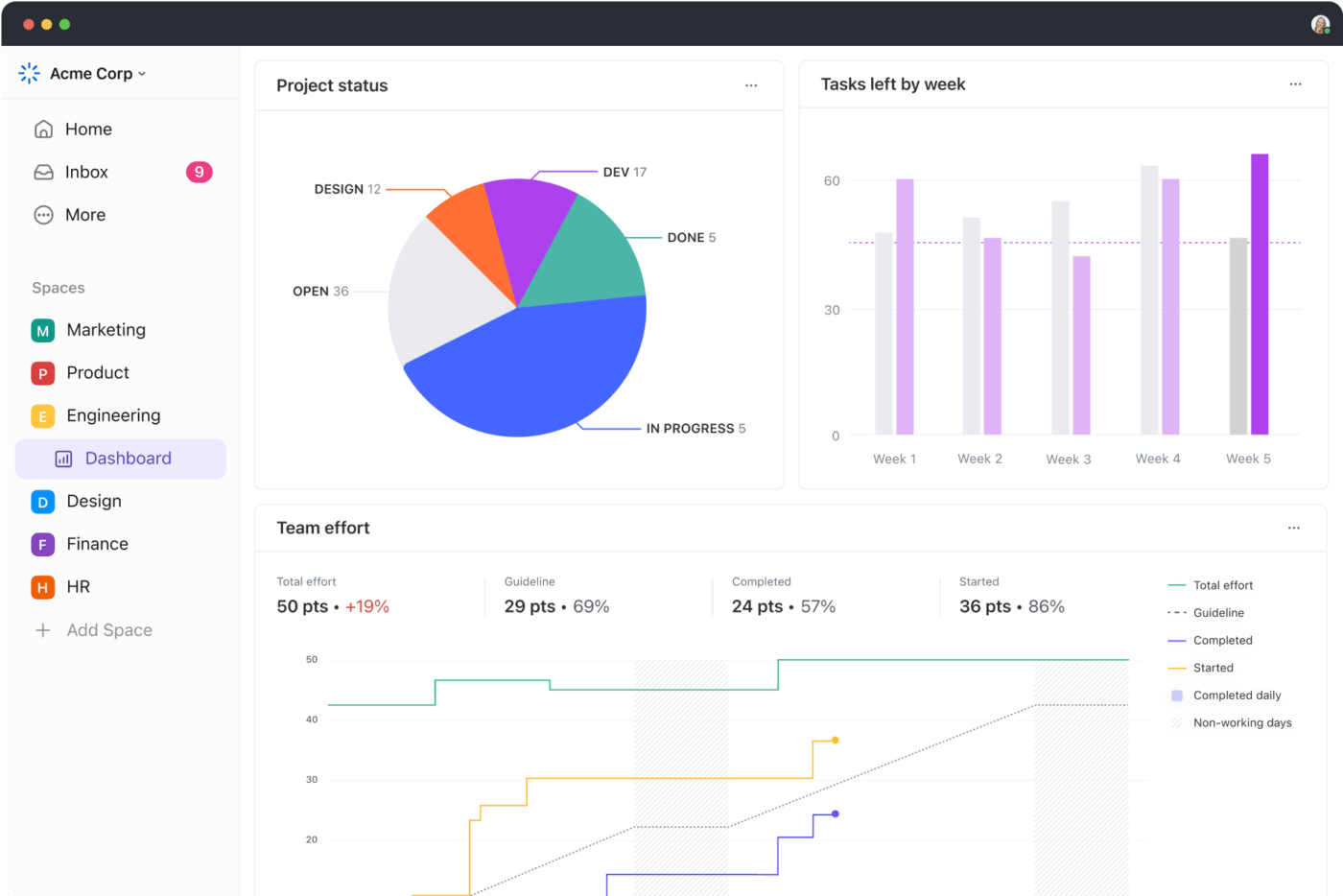
احصل على عرض شامل لحالات المشاريع والمهام المتبقية في فريقك أو قسمك باستخدام لوحات المعلومات في ClickUp
أمثلة وقوالب تخطيط القدرات
لنلقِ نظرة على كيفية ترجمة هذه الاستراتيجيات والعمليات إلى بعض السيناريوهات الواقعية، باستخدام قالب عبء عمل الموظف في ClickUp .
مثال على استراتيجية التأخير
رايلي هي مديرة الإنتاج في شركة صغيرة تصنع حقائب يدوية حصرية مصنوعة يدوياً. وهي تعرف عدد حقائب اليد التي يتم بيعها شهريًا عبر متجرها على الإنترنت وتخطط وفقًا لذلك. 👜
في يوم من الأيام، حظت الشركة بضربة حظ جيدة، وصادفت إحدى المؤثرات منتجاتها. تروّج لحقيبتها المفضلة على قناتيها على يوتيوب وتيك توك، وفجأة أصبح الجميع يريد حقيبة واحدة. تتدفق الطلبات، وسرعان ما ينفد مخزون الشركة.
تستفيد الشركة من هذه الفرصة وتنشئ قائمة انتظار للحقائب، وتنشرها عبر قنواتها. يقوم رايلي بتخطيط السعة داخل نموذج عبء العمل ويدرك أنه يجب عليهم إضافة ثلاثة صانعي حقائب مهرة إضافيين إلى فريق العمل المكون من أربعة أشخاص. سيؤدي ذلك إلى زيادة مستويات مخزونهم بما يكفي لتلبية الطلب الجديد.

تصور مقدار العمل المخصص للمساهمين الأفراد وكذلك لكل فريق من فرقك باستخدام طريقة عرض عبء العمل في ClickUp
/ctaBtn/الأخضر https://app.clickup.com/signup?template=t-216058901 تنزيل هذا القالب /%ctaBtntn/
سوف يستغرق الأمر بعض الوقت لتوظيف الموظفين الجدد والوصول إلى سرعة الإنتاج الكاملة، لكن استراتيجية التأخير تعمل هنا لأن هذا منتج حصري - وقائمة الانتظار التي تم الإعلان عنها بشكل كبير تجعلها تبدو أكثر حصرية. فالزبائن مستعدون للانتظار ومتحمسون عندما يحصلون على حقائبهم أخيراً.
مثال على استراتيجية التأخير
أليكس هو مدير مشروع لشركة تسويق. وقد فازت الشركة للتو بعقد لإنتاج مواد تسويقية لشركة كبيرة، بدءًا من شهرين، وهناك أيضًا عقد آخر محتمل في طور الإعداد.
عندما يستخدم أليكس النموذج لتخطيط القدرات، يدركون أنه لا توجد طريقة يمكن لفريقهم الحالي المكون من ستة أشخاص التعامل مع ساعات العمل الإضافية لهذين العقدين دون الكثير من العمل الإضافي. 🕜
لذا، بينما كان العقد الأول لا يزال في طور الانتهاء وقبل أن يتم تأكيد العقد الثاني، قاموا بإجراء مقابلات مع أربعة موظفين جدد وتعيينهم. وبحلول الوقت الذي يبدأ فيه العقد الأول رسميًا، يكون الموظفون الجدد على أهبة الاستعداد للعمل.
يقوم أليكس ببعض المخاطرة لأن العقدين لم ينتهيا بعد، ومن الممكن أن يحدث خطأ ما، لكنهم يراهنون على احتمال أن يتم الأمران معاً. ستتمكن الشركة أيضًا من استخدام حقيقة أن لديهم بالفعل فريقًا يمكنه التعامل مع العمل كنقطة بيع للعقد الثاني.
وبالطبع، إذا لم يفوزوا بالعقد الثاني، فسيكون لديهم قدرة إضافية في فريقهم. بعد ذلك، سيحتاجون بسرعة إلى البحث عن المزيد من الأعمال أو التخلي عن بعض الموظفين الإضافيين.
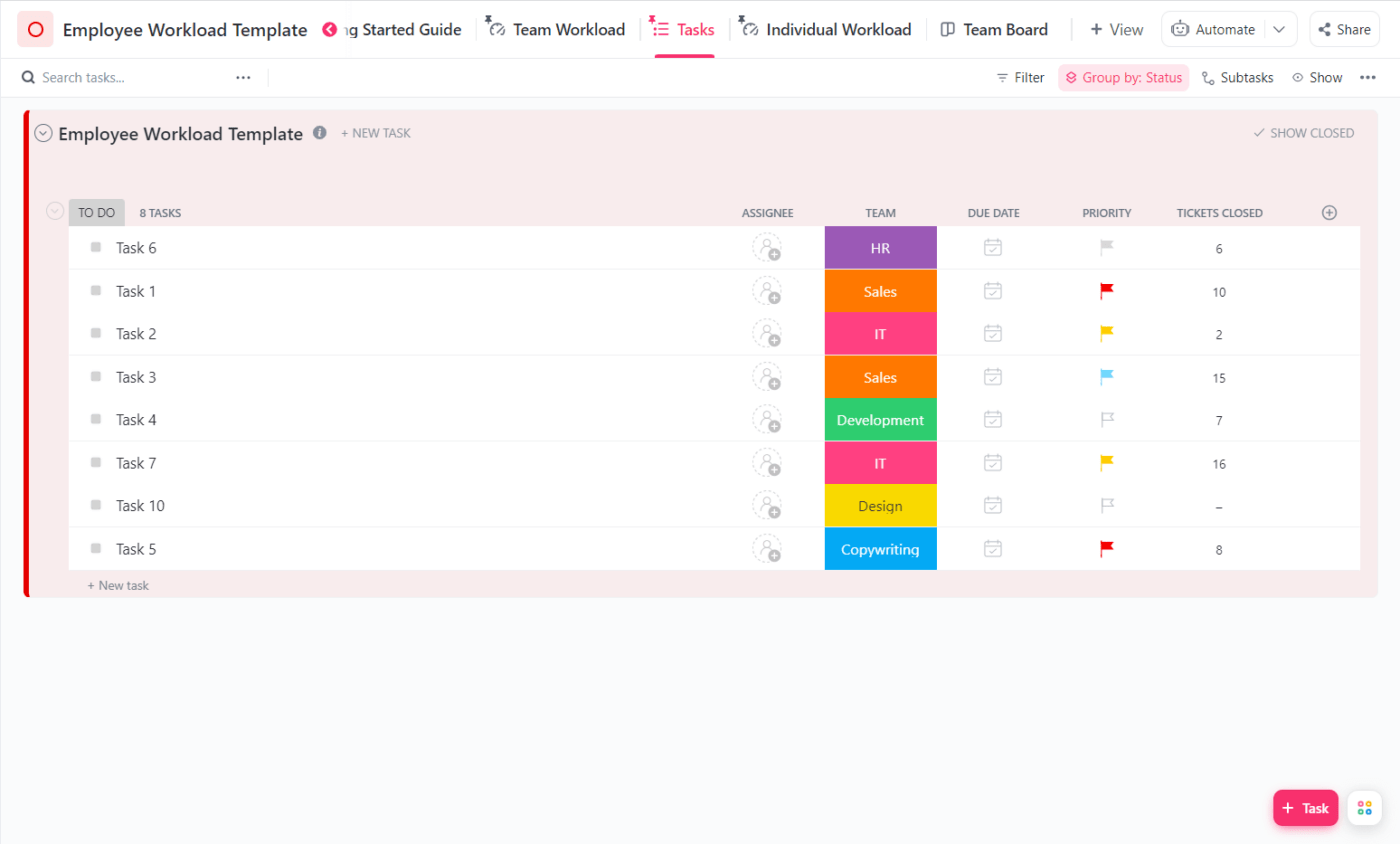
استخدم طريقة عرض القائمة لتخطيط مهام فريقك المستقبلية
مثال على استراتيجية المطابقة
يدير جيمي فريقًا مكونًا من ثمانية وكلاء مركز اتصال يعملون بنظام الورديات في شركة بيع بالتجزئة. 🎧
الشركة على وشك تقديم عرض خاص من المرجح أن يجذب الكثير من الاهتمام. قد يتلقون العديد من المكالمات الإضافية إلى مركز الاتصال، ولكن هناك أيضًا الكثير من المعلومات على موقعهم الإلكتروني والقنوات الأخرى.
يستخدم جيمي نموذج عبء العمل ويحسب أن كل وكيل لديه بعض السعة، ولكن إذا تلقوا الكثير من المكالمات، فسيحتاجون إلى مساعدة إضافية. فبدلاً من تعيين موظفين إضافيين، طلبوا من بعض أعضاء فريق المناوبة البديلة أن يكونوا تحت الطلب.
تُمكّن استراتيجية المطابقة جيمي من توخي الحذر في قراراتها، واستقدام مساعدة إضافية عند الضرورة فقط. لن تكون هناك نفقات غير ضرورية إذا لم تكن هناك حاجة لأعضاء الفريق الإضافيين. ومع ذلك، إذا احتاجت إلى استقدام أعضاء فريق إضافيين، فإن زيادة المبيعات من الاستفسارات الهاتفية الإضافية ينبغي أن تكون كافية لتعويض التكلفة.
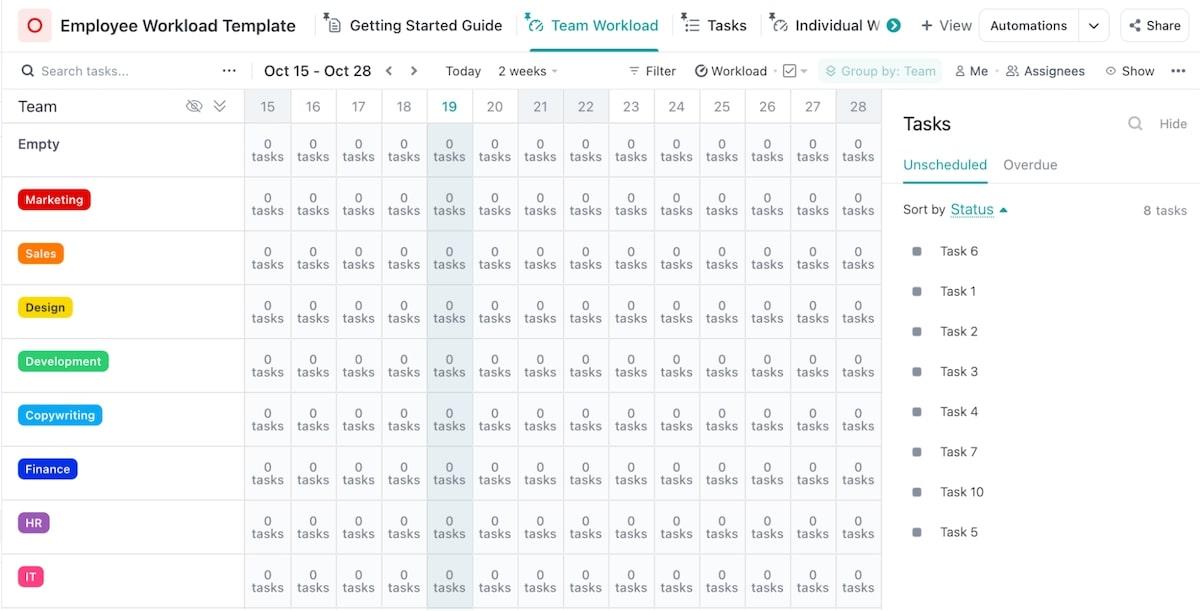
افتح عرض عبء عمل ClickUp أثناء تخطيط الموارد للحصول على أحدث المعلومات
تخطيط القدرات الرئيسية لمساعدة عملك على الازدهار
يساعدك تخطيط القدرات على فهم مقدار العمل الذي يمكن لفريقك التعامل معه بالضبط. فهو يقارن السعة الحالية بالطلب القادم ويحدد ما إذا كنت بحاجة إلى تعيين موظفين إضافيين. وهذا يضمن الكفاءة والإنتاجية واتخاذ قرارات أفضل، مما يؤدي إلى زيادة الأرباح. 🙌
الطريقة المتأخرة هي استراتيجية تخطيط السعة الأكثر تحفظًا، والتي لا تزيد الموارد إلا عند وجود طلب مؤكد. أما الطريقة الاستباقية فهي استباقية ذات مخاطر ومكافآت أعلى، بينما تهدف استراتيجية المطابقة إلى إيجاد حل وسط بين هذين النقيضين. تصلح كل استراتيجية لأنواع مختلفة من الأعمال والحالات المختلفة، لكن القوة تكمن في التخطيط الجيد. اشترك مجانًا ، وابدأ في استخدام ClickUp لإتقان إدارة السعة اليوم. ✨

